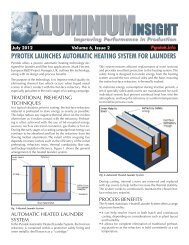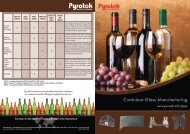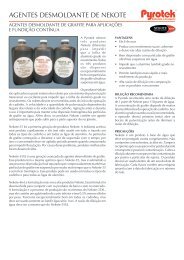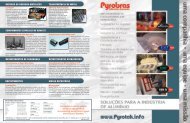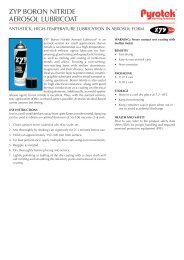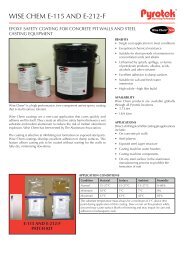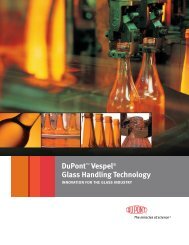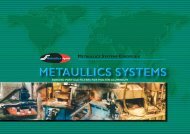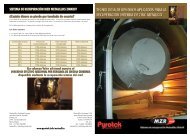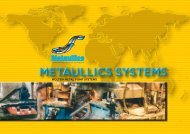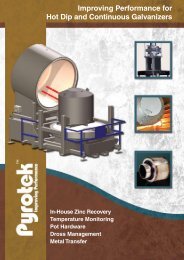GlassInsight_5-2013_.. - Pyrotek
GlassInsight_5-2013_.. - Pyrotek
GlassInsight_5-2013_.. - Pyrotek
You also want an ePaper? Increase the reach of your titles
YUMPU automatically turns print PDFs into web optimized ePapers that Google loves.
4ask the expert...determining the best guidematerial in container productiongerresheimer group predictscontinued revenue growth in <strong>2013</strong>Gerresheimer AG, a Düsseldorf,Germany-based developer andmanuf-acturer of glass and plasticpackaging, projects its revenues willgrow 5–6 percent in <strong>2013</strong>. Its revenuesincreased 11.4 percent to EUR€1.2billion (USD$1.6 billion) in 2012.Larry Rizzuto,Glass Sales Engineer,<strong>Pyrotek</strong> Inc.In glass container manufacturing,bottle guides are an important componentwith various functions thatare used on individual section (IS)machines and the production line.If the forming process were an exactscience, there wouldn’t be any needfor bottle guides on the line’s deadplates, conveyor, ware-transfer unitor cross conveyor. Several factors thatinfluence ware handling, however,include container weight, variationsin air pressure, valve response time,timing parameters, machine cooling,deadplate cooling and man-coolingsystems.Many materials have been used overthe years as bottle guides, includingcovered wires, DuPont Kevlar ®tape, plastic tape, DuPont Teflon ®tubing, carbon, graphite and stainlesssteel. They are used for the sole purposeof guiding containers from thedeadplate to the machine conveyorto keep the containers from tippingover. Once on the conveyor, theyhave to be orientated in a straightline or a jam can occur.A container material’s resistance tohigh temperature and porosity determinewhich substance to use asbottle guides in any operation. If theguide material is damaged to a pointthat bare metal under the coating isexposed, a contact check can occuron the glass. If the material becomessaturated with oil, a contact checkmay also occur. Either of these conditionscan cause a container defectresulting in lost production or a customercomplaint.The following paragraphs detail thestep-by-step process of a container’strip from the IS machine to the annealinglehr.1. As a container leaves the deadplate,it can be directed by acurved guide, which is usuallymade of carbon or graphite. It maybe also assisted by air jets that turnon and off to hold the containerin the pusher pocket. Some operationshave used covered wiresor a coated tape to do the samething. The curved guide is the bestapproach because it will not dentthe container as a wire or tapemight do. The curved guide canbe made out of DuPont Vespel® SCP-5050 polyimide part or<strong>Pyrotek</strong>’s P-25W carbon / carbonmaterial.2. Once the container is moving onthe conveyor, an inside or outsideguide on the conveyor moves anymis-orientated containers back inline. The purpose of the guidesis to keep containers in a straightline through the narrow openingof the hot-end coating hood withoutjam-ming and to sequencethem into the ware-transfer unitwithout letting them fall over. <strong>Pyrotek</strong>has found that DuPont’sVespel ® SCP-5050 polyimidepart works best because it will resistoil, and won’t bend or easilybreak. Vespel ® components haveapproximately 50 to 100 timeslower heat transfer coefficientversus traditional carbon graphitecomponents, which can eliminatechecks and micro-cracks in theglass containers.3. Next, as a container contactstransfer fingers, the transfer unitwill turn the bottles 90 degreesto move them onto the cross conveyor.A guide under the transferkeeps the containers in a straightline as they enter the cross conveyor.Sometimes an upper guidemay also be used for added bottlestability. These materials are usuallymade out of graphite, carbon,polymer-matrix composite (PMC)or Vespel ® . The first three materialsmight break or wear out prematurely,causing downtime. Manyplants have been using Vespel ®components with good success.4. Once on the cross conveyor, thestacker will push the containersinto the annealing lehr. Temperaturesare very high in this area.Carbon material such as P-25Wis an excellent choice for stackerpocket inserts as temperatures aretoo high for Teflon ® , PMC and Vespel® materials. Graphite has alsohad its problems in this area as itwill cause contact checks on theside of the containers.To ensure glass container quality duringthe manufacturing process andavoid cost-inducing checks and defects,several ware-handling factorssuch as container weight or variationsin air pressure must be considered.<strong>Pyrotek</strong>’s global network of engineerscan work with a customer to determinewhich guides and materials willimprove production performance.www.pyrotek.info/glassDuPont, Kevlar ® , Teflon ® and Vespel ® areregistered trademarks or trademarks of E.I.du Pont de Nemours and Company or itsaffiliates. All rights reserved.The company saw strong growth inthe pharmaceutical segment, as wellas positive results in cosmetic glassand life science research.“We achieved all our targets in 2012.We recorded another year of stronggrowth in our business activities with Photo courtesy of Gerresheimer AG.the pharmaceutical sector, which onceagain proved to be relatively immuneto cyclical effects. We are investing heavily in expanding our production capacityfor medical devices such as prefilled glass syringes, insulin pens and inhalers.We are also focusing on the fast-growing emerging markets, especially in China,Brasil and India,” Uwe Röhrhoff, Gerresheimer’s CEO, said in a press release.The company is expanding its production capacity for medical products inGermany, the Czech Republic and elsewhere. Last year, Gerresheimer acquiredNeutral Glass, one of India’s leading manufacturers of pharmaceutical vials, andTriveni, an Indian plastic pharmaceutical packaging and closure manufacturer.The company is considering additional acquisitions, it says.Gerresheimer’s products include glass tubing, vials and syringes. Its RTF ® -brand ready-to-fill glass syringes can have multicolor printing, a laser-appliedidentity code and a tamper-evident closure system. They are also delivered tothe pharmaceutical industry sterile, pre-assembled and, if desired, with bakedonsiliconisation, the company says. Gerresheimer’s pre-fillable syringes can bemanufactured to a customer’s specifications and are technically compatible tostandards within the pharmaceutical industry.The company’s moulded glass packaging caters to the pharmaceutical, cosmeticsand specialty beverage industries. Its products include type I borosilicate glassand sodium-silicate glass of types II and III amber and flint glass, as well ascoloured and opal glass.Gerresheimer employs about 11,000 people at 47 locations in Europe, Northand South America and Asia.o-i, ecullet form joint ventureOwens-Illinois Inc. (O-I), of Perrysburg, Ohio, USA, and eCullet Inc., of PaloAlto, California, USA, have formed a joint venture called Glass to Glass LLC.The new company will invest in sophisticated glass sorting equipment that willmake more high-quality recycled glass available for use in O-I plants, Owens-Illinois says. Using recycled glass in the manufacturing process allows thecompany to reduce its use of virgin raw materials, lessening its environmentalimpact.“Much of the recycled glass collected in North America comes from singlestreamrecycling, which mixes paper, metal, plastic and glass,” Owens-Illinoissaid in a press release. “This collection process often results in glass that is toocontaminated to be successfully re-introduced into the manufacturing process.Improved sorting techniques will increase the amount of usable glass availableto O-I.”eCullet is a glass processing company that utilises proprietary technology toproduce high quality cullet (i.e. broken or refuse glass) that is colour sorted,contaminant free and furnace ready for the glass container manufacturingindustry.Separately, Glass International reports that O-I has completed a EUR€21 million(USD$27 million) investment at its Leerdam plant in the Netherlands to enhanceits capabilities. The investment included a furnace rebuild, machine upgradesand new equipment.“The investment at our Leerdam facility is part of O-I’s strategy to significantlystrengthen our competitiveness and capabilities in Europe. In <strong>2013</strong>, we will beinvesting EUR€140 million (USD$180 million) in our European operations,” O-IEurope President Erik Bouts told Glass International. “Over the next several years,we will accelerate our efforts to enhance O-I’s capabilities to better supportthe growing needs of our European customers for sustainable and healthy glasspackaging.”Owens-Illinois is the world’s largest glass container manufacturer with about22,500 employees at 79 plants worldwide. It had revenues of USD$7 billion in2012.
google demonstrates its wearableinterface, google glassGoogle, the Mountain View,California, USA-based informationtechnology company, demonstratedits interactive product, Google Glass,at the recent South by Southwestconference in Texas, USA.Still in the developmental phase,Glass basically is a pair of eyeglassesthat features a head-up display (HUD)a user can use to take photos andaccess and share information via theInternet.Google Glass photo courtesy of Google.“Project Glass is about our relationship to technology. It’s about technologythat’s there when you want it and out of the way when you don’t,” TimothyJordan, a Senior Developer Advocate at Google, told the audience. “Technologygets in the way more than it needs to. Glass is so you can still have access to thetechnology you love, but it won’t take you out of the moment.”The glasses’ HUD is positioned just out of a user’s direct line of sight and isactivated and deactivated by head gestures. It also includes a touch pad on theside. Glass features an audio component that allows a user to voice commandsand emails and hear responses.Glass’ HUD utilises application programming interfaces, or APIs, to communicatebetween its servers and applications and send and retrieve data, which isdisplayed on “timeline cards.” Jordan demonstrated Google’s new Mirror API,which is the main interface between Google Glass, Google’s servers and anyapps developers create for the product. He challenged potential developers todesign new applications for short and quick interactions, to be discrete, timelyand avoid unexpected notifications or actions that would frustrate a user. “Keepaway from anything that’s going to jar them or shock them out of their lives,”Jordan said.In one example, Jordan demonstrated how a user might receive a headlinenotice from the “New York Times,” tap on a story he or she is interested inthen quickly share it through social media. Or, a user could opt to have thestory read aloud in his or her ear while walking between meetings. “Glass isin early days yet. We’re really just getting started,” Jordan said. “The reasonwe want to start having this conversation is that every time we say somethingand you (developers) respond with your dreams and visions for using this newtechnology, it’s a huge inspiration to us.”Earlier this year Google invited individuals to its Glass Foundry, where teamsbrainstormed and built new potential ways to use Glass.Google Glass is one of several similar products using HUDs that are on themarket or being developed. Epson’s Moverio BT-100, for example, is an individualentertainment system embedded in a pair of glasses, letting a user watch videoand explore the Internet. The Vuzix M100 Smart Glasses offer a hands-free visualdisplay of data on a smartphone, while Innovega iOptik contacts are designed todisplay information on contact lenses.berlin packaging expands presence inflorida, USA, with new warehouseBerlin Packaging, of Chicago, Illinois,USA, has opened a 3700-squaremetre(40,000-square-foot) warehousein Miramar, Florida, USA,to accommodate its growth in thatregion. Berlin Packaging suppliesglass, plastic and metal containersand closures through its more than 90locations throughout North America,the company says.The new facility, which is expected tobe fully operational within the nextseveral months, will house customers’packaging components for just-intimedelivery and enable the companyto offer same-day shipping to virtuallyall of Florida. Customers have theoption to have finished containersand closures drop-shipped directlyfrom the factory to their preferreddestinations, or housed at warehouseslike the new Miramar facility forrelease on an as-needed basis underthe company’s inventory managementprogram, the company says.In addition, the company plans toopen a new office in Miami, Florida.“Our sales in Florida have surgedtremendously in the last year, inpart because of an aggressive salesand marketing campaign focusingon services such as package design,global sourcing, capital lending atbelow-market rates and consultingthat we offer free of charge inexchange for new packaging business.That growth prompted us to look formore warehouse space that we canstaff with our own personnel,” DarrinDingman, Berling Packaging’s FloridaDistrict Manager, Berlin Packaging,said in a press release.With nearly USD$800 million inannual revenues, Berlin Packagingsupplies more than 3.5 billioncontainers and closures each year, aswell as labelling and filling services tocompanies in industries such as foodand beverage, health care, automotiveand industrial chemical.cugher glassmoves, installsline at new PGWplant in PolandCugher Glass, of Milan, Italy, hasmoved its production operations to alarger facility in the Novate Milaneseindustrial area in Milan. The companyoccupies a 1000-square-metre(10,800-square-foot) building whereit is equipped to assemble and test itsmachines, the company says.In Komorniki, Poland, Cugher hascompleted the installation of screenprinting lines at a new PittsburghGlass Works (PGW) factory.“The line is equipped with advancedautomation features in order toguarantee an outstanding performancein terms of speed, precision andquality of the final product,” Cughersaid in a press release.China proposes bottle recyclingfee, eyes legislation in hong kongThe Chinese government has proposedlevying recycling fees on all glassbeverage suppliers and distributors,domestic and foreign, in the city ofHong Kong.While the fee hasn’t been determined,the government has announced apossible figure of HKD$1 (USD$0.078)per litre, says a staff report from theU.S. Department of Agriculture’s(USDA) Foreign Agricultural Service.In the past 10 years, glass bottlesaccounted for about 3 percent ofHong Kong’s solid-waste disposal. In2011, glass bottles used for beveragesconstituted two-thirds of overall glassbottlewaste, the report says. Onlyabout 1500 tonnes of glass beveragebottles were recovered that year in avoluntary recycling program.In the proposal, suppliers will berequired to periodically report theamount of glass beverage bottlesthey have provided to the HongKong market for consumption, whichwill determine the recycling fee acompany must pay, the USDA reportsays. Based on 2012 trade figures,USA-based wine and beer beverageswould have generated USD$958,0005industry eventsjune <strong>2013</strong>17–20 JuneMir Stekla <strong>2013</strong>Moscow, Russiawww.mirstekla-expo.ruseptember <strong>2013</strong>3–5 SeptemberGulf Glass <strong>2013</strong>Dubai, United Arab Emirateswww.glassinthegulf.com4–6 SeptemberGlass SolutionsOrlando, Florida USA11–12 SeptemberGlassman AmericaLas Vegas, Nevada, USAwww.glassmanevents.comoctober <strong>2013</strong>14–17 OctoberGlass ProblemsColumbus, Ohio, USAwww.gmic.orgin recycling fees in a year, withan average cost of 1.6 percent perbottle. The proposal also includes anexemption for suppliers who employ asystem to collect their own containers.The government will select one ormore contractors to collect and treatused containers, while retailers will berequired to educate the public.The wine industry has opposed theproposal, citing that the fee will affectinexpensive beverages the most, andsellers will be forced to raise pricesto account for the levy. Assuming thesuggested levy of HKD$1 (USD$0.078)for a one-litre bottle, the recycling feewould be as high as 8 percent for a500-millilitre (16-ounce) soft drink.For an HKD$100 (USD$13) bottle ofwine, however, the rate would only beabout 0.8 percent.Meanwhile, Hong Kong media reportsthat the government is consideringlegislation to make glass recyclingmandatory. New measures areexpected to be introduced by theend of the year, the South ChinaMorning Post says. It has not yet beendetermined who would be responsiblefor recycling, but possibly importers,wholesalers or retailers.
6SAGE reports record sales in 2012SAGE Electrochromics Inc., aMinneapolis, Minnesota, USAbasedmanufacturer of dynamicwindow glass, reported record salesand opened a new facility in 2012.SAGE’s signature product is electronicallytintable glass, calledSageGlass ® , that controls heatgain and glare in a building,optimises daylight and increasesenergy efficiency while preservingSageGlass was installed at Pennsylvania,USA’s Kimmel Center to make its event spacecomfortable year-round. Photo courtesy of SAGE.the outdoor view, the company says. SageGlass, an alternative to mechanicalwindow shades or blinds, can reduce a building’s cooling load by 20 percentand HVAC requirements up to 30 percent.Recent commercial projects that have used SageGlass include the KimmelCenter for the Performing Arts, in Philadelphia, Pennsylvania; the University ofKansas Center for Design Research; the research facilities at the U.S. Departmentof Energy’s National Renewable Energy Lab; and the Mille Lacs Band of Ojibwetribal headquarters, all in the USA.Last year, SAGE completed construction of a 30-square-metre (324,000-squarefoot)facility in Faribault, Minnesota, that produces dynamic glass in largearchitectural sizes in high volumes, the company says.Meanwhile, SAGE and architectural glass fabricator, Viracon, have entered intoan agreement in which SAGE markets and sells a line of SageGlass productsthat incorporate a Viracon exterior. “This product integration will give customersmore aesthetic options for solving a variety of glazing challenges in their buildingprojects,” SAGE said in a press release.Also last year, France-based materials company Saint-Gobain purchased SAGE,making it a wholly owned subsidiary.“We are firing on all cylinders,” said John Van Dine, SAGE founder and CEO, ina press release. “The technology is proven. Interest in SageGlass from architectsand building owners has never been stronger. We’re ramping up high-volumeproduction, and we’re supported by the global research and resources of theworld’s greatest building materials company.”P&G achieves zero manufacturingwaste at 45 of its plants worldwideProcter & Gamble (P&G), a Cincinnati,Ohio, USA-based manufacturer ofhousehold products, cosmetics andother goods, recently announcedit has achieved its goal to send lesswaste to landfills by producing zeromanufacturing waste at 45 of itsfacilities worldwide.Over the past five years, P&G’s effortto find worth in its waste has createdover USD$1 billion in value, says thecompany.The company asserts that 99 percentof materials entering its plants leavesas a finished product or is recycled,reused or converted to energy. P&Gsays it has achieved zero wastethrough quality assurance, packagingreduction, compaction and recyclingefforts.“There are well-defined systems forrecycling materials like paper, plasticand glass, but our product portfoliois incredibly broad, resulting in adiverse set of waste streams to findsustainable solutions for,” ForbesMcDougall, head of P&G’s globalzero manufacturing waste program,said in a press release. “We focusedon finding solutions for our toughestwaste streams at our largest sites. …We’re now seeing new sites achievezero manufacturing waste to landfillnearly every month.”P&G has operations in about 75countries.Publisher<strong>Pyrotek</strong> Inc.9503 E. Montgomery Avenue, Spokane Valley, WA 99206 USAwww.pyrotek.infoContact-Sandra Hoskingemail—editor@improvingperformance.comThis document is for information purposes only. The information contained in thisdocument has been compiled from sources believed to be reliable. While every efforthas been made to ensure that the information is correct and that the views are sound,Glass Insight cannot be made liable for any loss, no matter how it may arise.Glass Insight is produced by <strong>Pyrotek</strong> Inc. for its customers.Copyright <strong>2013</strong>. All rights reserved.nampak to invest in upgradesNampak, Africa’s largest packaging company, plans to invest R1.6 billion(USD$174 million) in two of its businesses that produce bottles and cans for thebeverage market.The South Africa-based company will invest nearly R1 billion (USD$109 million)and add a third furnace at its glass-bottle business in Roodekop, Germiston,South Africa. The new furnace will improve overall manufacturing efficiency atthe plant and enable it to supply a broader range of bottles, Nampak says.Nampak also will add aluminium beverage can capacity and convert existinglines from tinplate to aluminium. It also has installed a new high-speed line atits Springs plant.“These two projects strengthen our position in the beverage can and glasspackaging sectors in South Africa and show our commitment to growing theSouth African economy,” Tito Mboweni, Nampak’s Chairman, said in a pressrelease.rawlings introduces mini-jarRawlings & Sons (Bristol) Ltd., of the United Kingdom, has introduceda 43-millilitre (1.5-ounce) mini-jar. The clear jars are produced using apercentage of high-quality white flint recycled glass cullet. They are packagedto pharmaceutical standards and are geared toward the hospitality and travelindustries. They also are suited for use as product samples or promotionalitems, Rawlings says.Lightweight continued from page 1Coca-Cola Co. introduced its Ultra Glass bottle to reduce weight and costmore than a decade ago. The bottles are 20 percent lighter and 10 percent lessexpensive than traditional contour bottles, the company says.Waste & Resources Action Programme (WRAP) launched its Container Liteinitiative in 2007, which studied how consumers responded to lightweightpackaging. “Consumers very rarely compared the gross weight of two products atthe same time when making a purchasing decision.” Coors Brewers Ltd. reducedthe weight of its 300-millilitre (10-ounce) Grolsch and Coors Fine Light bottles,saving 4000 tonnes each year, WRAP reported.WINE INDUSTRYIn 2010, more than half of USA wineries had begun using lighter weight bottles.Glass bottles, from 198 milliletres (7 ounces) to 4 litres (1 gallon) accountedfor nearly 83 percent of wine sales by volume in 2010, the Glass PackagingInstitute says. “Wine glass bottle suppliers are turning out ever-greener bottleswith an improved carbon footprint. Owens-Illinois, Verallia / Saint-Gobain, andother glass suppliers now make even lighter weight glass bottles to save onmanufacturing and shipping costs and are using more recycled glass bottles inthe manufacturing process, saving energy and reducing emissions.”USA-based Owens-Illinois Inc. (O-I), the world’s largest manufacturer of glasscontainers, launched its lightest North American wine bottle in 2010. It is 27percent lighter than a traditional bottle and weighs 340 grams (12 ounces). At thetime, Stan Gossett, Vice President and Category Director for O-I’s North AmericaWine, said, “We are proud to offer additional lightweight packaging optionsthat help customers realise higher environmental savings, while retaining thestrength and premium images for which O-I packaging is known.”Verallia introduced an eco-friendly bottle, now called Ecove, in 2009. “Thesebottles average 15 percent less weight than bottles of their comparable standarddesigns,” yet they have the same wall thicknesses. Saverglass, of France, releasedits Eco-Design range of bottles for wines and spirits in 2010, and Fetzer, aCalifornia, USA, winery launched a lightweight bottle initiative in 2008 thatreduced its carbon footprint.According to Wines & Vines, “Lighter weight bottles are here to stay, but their usemay have leveled out.” Most manufacturers offer a lighter bottle but the growthof the trend has plateaued.New Canadian rules, however, may contribute to lightweighting growth. TheCanadian government has required that manufacturers offer bottles weighingless than 400 grams (14 ounces). As of 1 January, Canada’s Ontario provinceestablished a maximum weight for glass wine bottles. Under the new rule,750-millilitre (25-ounce), non-hock wine bottles can’t weigh more than 420grams (15 ounces), which is about 20 percent lighter than the current averageweight of a standard wine bottle. For hock bottles, which are typically taller, themaximum weight is 450 grams (16 ounces).The global glass industry generates about USD$75 billion in revenues annually,First Research reports. Top exporters include Belgium, China, France, Germany,Japan and the USA. In 2011, European Union countries produced 20,800 tonnesof container glass. In Europe, glass container manufacturing volume grew 4.2percent in 2011, although volumes fell slightly in the United Kingdom. “Ifproduction volumes remain the same year-on-year, then lighter glass bottles meanthat more of them are produced and all U.K. glass container manufacturers havemade great progress in successfully reducing the weight of glass containers,”writes Theresa Green, of British Glass, in Glass Worldwide.





